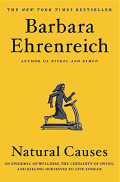Only a few centuries ago, the major source of moral and scientific authority in Western culture was religion, which requires trusting one of numerous supernatural deities. However, the presumption that medicine is based on evidence-based and peer-reviewed science is what gives it authority in modern culture. If independent experts cannot verify a scientific hypothesis, if the data are irreproducible, we are required to conclude that the hypothesis is not true. Since most of us are unlikely to learn enough of the calculus of science, math, and biology required to challenge a learned hypothesis, we also have to trust the body politic of science. However, Natural Causes: An Epidemic of Wellness, the Certainty of Dying, and Killing Ourselves to Live Longer questions the accuracy of much of evidenced medicine, and its author, Barbara Ehrenreich, goes deep into the fundamental unreliability of our own bodies.

In short, the author is an iconoclast whose messaging in this text is full of skepticism about the wellness industry. And she has street credentials, a PhD in cellular immunology from Rockefeller University and more than a dozen books under her literary belt, including The New York Times bestseller Nickel and Dimed.
BOOKMARK
- Title: Natural Causes: An Epidemic of Wellness, the Certainty of Dying, and Killing Ourselves to Live Longer
- Author: Barbara Ehrenreich
- Publisher: Twelve
- Publication date : April 2018
- Price: $28.50, hardcover, 256 pages
Unvarnished Look at the Wellness Industry
ORGANIZED IN 12 concise chapters, Natural Causes is a serious book by a breast cancer survivor who draws from varied sources to examine the way we obsess over death, our bodies, and our health. In summary, the book’s first half is devoted to describing the so-called quest for control as it is acted out through medical care, such as lifestyle adjustments in the areas of exercise and diet and then the realm of biology.
At age 76, and in good health, the author renounces the value of routine checkups and early detection tests for major killers such as cardiovascular disease and cancer. In fact, she freely admits that she’s reached a point in her life when she’d old enough to die.
She writes: “Once I realized I was old enough to die, I decided that I was also old enough not to incur any more suffering, annoyance, or boredom in pursuit of a longer life.” The reader will find no “how-to” advice; there are no tips about how to extend your life, upgrade your diet, add an exercise regimen, or fine-tune your attitude in more healthful directions. “I hope this book will encourage you to rethink the project of personal control of your body and mind…. I present the emerging scientific case for a dystopian view of the body—not as a well-ordered machine, but as a site of ongoing conflict at the cellular level that ends in death.”
Immune System: Friend and Foe
ALTHOUGH MS. EHRENREICH tends to overdramatize the internal struggles of aging and mortality, her central theme is based on an important existential question: Are we killing ourselves to live longer, not better? And along the way, she poses some interesting questions and scenarios about “successful aging,” tracing the concept to the 1980s and throughout the Western world, where it also goes by such names as “active aging,” “productive aging,” or “anti-aging.” One by one, the author dismantles the popular beliefs that guide our path to a longer healthier life. And she can be both funny and caustic when discussing how to live well and joyously while at the same time accepting our mortality.
“I hope this book will encourage you to rethink the project of personal control of your body and mind.”— Barbara Ehrenreich
Tweet this quote
For readers of The ASCO Post, the most interesting content is on the immune system, which is what inspired Ms. Ehrenreich’s book. In the 1960s, as a PhD student, she worked on immune cells, particularly macrophages, embracing them as powerful front-line soldiers in the defense of our bodies. However, the tumor microenvironment is a complex setting, and we now know that immune cells in this microenvironment can be tricked by tumor cells to help promote angiogenesis, suppressing the antitumor immune response and promoting growth by secretion of growth factors.
Ten years ago, Ms. Ehrenreich read an article in Scientific American about this very subject, and it had a profound effect on the way she looks at the human body and life itself. She explores the immune system with a keen eye, sometimes as an interrogator questioning a traitor, but throughout, it proves to be the best sections of the book. Her discussion on inflammation and cancer is erudite and pleasantly concise. “Chronic smoldering collections of inflammations can easily ignite into conflagrations,” she writes.
In Summary
THERE IS A lot to digest in this small dense book, which throws hard science, personal opinion, and challenging social issues into the same blender. Ms. Ehrenreich has taken a chance here, and for that alone she deserves credit. Despite overkill at time, she makes a sound case against the issue of overdiagnosis with which the oncology community wrestles.
There is a lot in this book to take issue with, especially the banal insistence that death comes to even those who have worked hard at staying healthy. However, the lucid and thought-provoking sections on the immune system and inflammation make it a worthwhile book for The ASCO Post readership. ■

